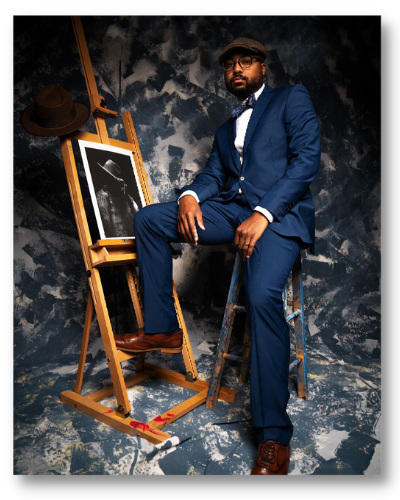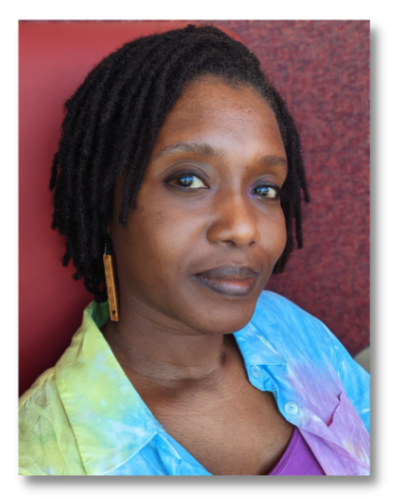
Featured Navigation Links
ARCHIVE
all galleries
HEDREEN GALLERY
current season
VACHON GALLERY
current season
ARTS@Seattle U
Calendar
Blue is Our Color
June 24 - October 7, 2022
Hedreen Gallery, Lee Center for the Arts (CNFA) at Seattle University
Open Wednesday through Saturday from 1-6pm
Blue contains whole worlds in its shades- the twinkle of sapphires, the inky hues of a storm at sea, or the spotted simplicity of a robin's egg. Blue is a spectrum and its variations are a fitting way to hold past, present, and future stories of Black people… the joy and jubilee, the pain and protest, the personal and communal. In the Blue exhibit, the ‘old’ is represented by yards of indigo-dyed Àdìrẹ from Nigeria and guinea fowl indigo designs from Mali. These symbols are put in dialogue with contemporary large-scale fabric collages, eye-catching abstractions, and cyanotype photographs of the 2020 demonstrations against police brutality. As a visual thread, blue (and by extension, ideas of Blackness and African-ness) is shown to hold much more than stagnant history and simplistic ideas of identity.
 About Àdìrẹ
About Àdìrẹ
Àdìrẹ is derived from two Yoruba words- Adi which means ‘to tie’ and Re which means ‘to dye’. There are various methods to create the patterns, including starch resist (Àdìrẹ Ẹlẹ’kọ), tied resist (Àdìrẹ Oníko), stitch resist (Àdìrẹ Alábẹrẹ) and more recently, wax resist (Àdìrẹ Batik) which is how the cotton damask patterns in this exhibit were made. The designs and symbols on Àdìrẹ fabric are commonly laid out in 8x8 inch squares, each containing a pattern that simulate cultural items and proverbs about musical instruments, common plants in Yoruba culture, being at personal or community crossroads and seeking good fortune. Due to COVID travel restrictions, the Àdìrẹ shown in this exhibit were purchased from a UK-based Etsy vendor who sources the textiles from artisans in Oṣogbo, Nigeria. Learning about these patterns is a cultural memory with aesthetic ties to the contemporary artwork in the exhibit.
About the Artists
 Jite Agbro
Jite Agbro
Jite Agbro is a Nigerian American print artist who grew up in Seattle, WA. Her colorful figurative work features layered patterns, sharp contrast, and fabric-like textures. She uses traditional and non-traditional printmaking techniques such as collage, sewing, and encaustic to transform paper and fabric into bold silhouettes with striking backgrounds.
Jite studied Fine art at Cornish College of the Arts and California College of the Arts before completing a BA in Environmental Design at Evergreen State College and an MS in Design and Engineering at the University of Washington.
Seattle-area organizations whereby Jite has received support and project funding include MAD Art, Bainbridge Island Museum of Art, The Neddy Foundation, 4Culture, Artist Trust, Shunpike, Pratt Fine Arts Center, and The James & Janie Washington Jr. Foundation.
 Marin Alexis Burnett
Marin Alexis Burnett
Marin Alexis Burnett is a self-taught artist from New York. After graduating from Williams College and the George Washington University she began living and working in Washington, DC where she began making artwork as a way to escape a stressful career. Her art has evolved over time to what you see today. Marin’s artistic focus is human figures and portraiture and in particular ways to depict the Black experience in America. She seeks to find the richness of love, pain and resilience in the figure’s crafts.
Marin’s artwork has been featured at the Henry Art Museum, The Great Jones Gallery, the Gallery Onyx, The En Pop Up Gallery and the Hillman City Collaboratory in Seattle. In Maryland and D.C., she has been featured at the State House of Representatives in Maryland as well as the Amber Tree Gallery. Marin’s work was selected as a fourth-place winner of the Benhaus Prairie Art Gallery’s 2019 juried show, “Text and Pictures” and was featured on the VH1 television series The Breaks. When she is not working as a strategist for the Port of Seattle, she is in her art studio or spending time with her husband and young son in their home in Renton.
 Aboubakar Fofana
Aboubakar Fofana
Born in Mali and raised in France, Aboubakar Fofana is a multidisciplinary artist and designer whose working mediums include calligraphy, textiles and natural dyes. He is known for his work in reinvigorating and redefining West African indigo dyeing techniques, and much of his focus is devoted to the preservation and reinterpretation of traditional West African textile and natural dyeing techniques and materials.
Fofana's work stems from a profound spiritual belief that nature is divine and that through respecting this divinity we can understand the immense and sacred universe. His raw materials come from the natural world, and his working practice revolves around the cycles of nature, the themes of birth, decay and change, and the impermanence of these materials. He sees the conception and realization of this work as a form of spiritual practice, which is shared with his audience.
Fofana is currently deeply involved in creating a farm in conjunction with the local community in the district of Siby, Mali, in which the two types of indigenous West African indigo will be the centerpiece for a permaculture model based around local food, medicine and dye plants. This project hopes to contribute to the rebirth of fermented indigo dyeing in Mali and beyond and represents his life's greatest project to date.
 Brian LaMar
Brian LaMar
Brian LaMar is an Air Force veteran, a photographer and a videographer. His work concentrates on street, social, and studio photography.
Brian is currently pursuing a BFA in photography at Seattle University. Brian took an interest in social photography through his travels with the military and now creates work that documents not only beauty, but the struggle that connects us.
 Moses Sun
Moses Sun
Moses Sun is a curator and interdisciplinary artist who specializes in abstract murals and large-scale works. He expresses Blackness across multiple media platforms, laying bare his personal history and humanity.
He speaks of turning from “the worst parts of the European diaspora that colonized my mind, life, and art” and turning to “African, Black, Latino, and Asian diasporas that have accepted me whole and given me strength when Whiteness has taken what it pleases, disposing of what it deemed too much and too loud.”
About the Curator
 Adetola Abatan
Adetola Abatan
Adetola Abatan is a collage artist, drummer, engineer and emerging arts leader with deep roots in Nigerian and American culture. Her artwork was featured in the 2021 Seattle Deconstructed Art Fair at Wa Na Wari (where she also completed an artist residency), the 2022 “After the Quiet: On Black Figures and Folds” exhibit at Mini Mart City Park, as well as the 2022 “Solace and Solitude” solo exhibit at the University Unitarian Church.
She is a 2022 graduate of the MFA in Arts Leadership program at Seattle University, in addition to a MS/PhD in Chemical Engineering from the University of Pittsburgh. She looks forward to creating and curating stories of Africans in the Diaspora.
Face coverings are highly encouraged for all visitors attending "Blue is Our Color" in the Hedreen Gallery at Seattle University. This encouragement comes from the Performing Arts & Arts Leadership and the Art, Art History, and Design Departments as an added precaution to create space for ALL members of the community to enjoy this exhibit.
Hedreen Gallery
Lee Center for the Arts (CNFA)
Open Wednesday through Saturday from 1-6pm